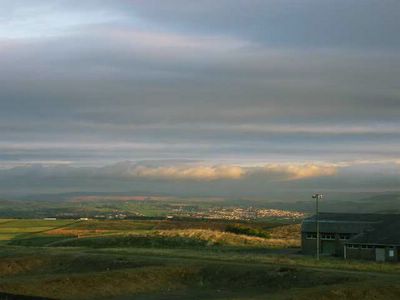Watchpoint 10-10-2005
Monday 10th October 2005
0710 - 1015hr (DCB, JS)
Weather and Sky:
A fair but deteriorating morning with increasing cloud cover and wind speed picking up. Wind: SE F2 at 0545hr, becoming S F3 at 0715hr until 0930hr when picking up rapidly to S F5 gusting F7!!! And then remaining similar. Temp: 7 at 0545hr, 6 at 0630hr, increasing 9 by 0854hr and finally 10 by 1030hr. Specifically noted very little dew. Visibility: Settle NNW / Drax E initially, closing down Elslack Moor NNW / Ferrybridge by 0800hr. Cloud: Altostratus / altocumulus with some cumulus initially 2ok, becoming 5ok. No fractus. Pressure: falling since yesterday lunch time with QNH 1012 by 0545 and finally 1013hpa by 1030hr but still on a downward trend.
In some ways a disappointing morning with many fewer birds in the skies. In comparison to yesterday only 129 Meadow Pipits went through during the first hour (before 0800hr), with the visit count being only a small fraction of yesterdays. Highlights were a massive influx of Jackdaws into the area, in both big and small parties, some of which appeared to be moving west or north-west. This influx concurs more or less exactly with a similar but smaller influx, or (passage?) last year, but then I / we might not have been counting corvids quite as actively. Rooks also involved in the influx / movement. At 0835hr "tue" calls were heard from a bunting sp, to our west, but moving away SE unseen. Half an hour later at 0908hr I was scanning the ridge to our south-west when, just by chance a group of four Snow Buntings crossed my field of view climbing obliquely across the moor, all exceedingly obvious birds. I shouted and John got on them straight away as they crossed in front of us and away SSE. Common Scoters. At 0825hr (just before the Snow Bunts) a group of five ducks was noted crossing the clear sky, very high to our north in a tight waving line formation. Wing beats were very rapid, but it could be seen in the brilliant, but still low sunlight from behind our backs and brightly illuminating the birds that the uppers were unmarked mid, and in the light, to almost pale brown. A creamy cheek patch could be seen at at mid to max zoom as they crossed out to our north-west. The birds were flying at a height well above the moor tops and estimated to be c2000ft asl. Direction was due west – Ribble bound without doubt, which if the visibility had been clearer (currently only c 40km) they would have been able to see. The date however is unusual (I think) for scoters here over inland. Would these have been moulted birds on way to wintering waters or overshooting Baltic moulters from further north-east – I don’t know? Anyone got experience as to what the status of these overflying scoters might be. Have scoters been moving on the coast? Have read the "Movements " bit in BWP but all is still a bit wooly to me as I think it must have been to them!
Greater Canada Goose 2 > E
Common Scoter 5 > W
Sparrowhawk 1
Golden Plover 17 > S
Lapwing 9 > S
Curlew 1
Black-headed Gull 29 > S
Common Gull 1 > SW
Lesser Black-backed Gull 32 > SW
Wood Pigeon, Ring Dove 30 > S
Great Spotted Woodpecker 1 > SW
Skylark 1 > W
Swallow 22 > S
House Martin 8 > S
Meadow Pipit 316 > S and SW
alba Wagtail 20 > SE / S / SW
Blackbird 1 > S
Turdus sp. 3 > SW
Jay 1 > NW
Jackdaw 581 some > W and NW
Rook 53
Carrion Crow 32 some > S and SW
Starling 18 > S
Chaffinch 26 > various
Greenfinch 42
Goldfinch 54 > S and SE
Siskin 5 > W
Snow Bunting 5 SSE
Total: 1317 individuals, 28 species, 3:10 hours, two observers
Dave











